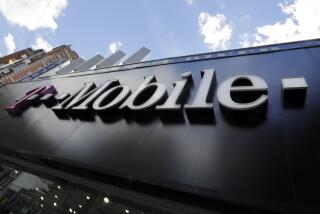Incoming! : Mobile phone carriers are swarming to cities, launching offensives against one another that result in lower prices (and not a little confusion) for consumers.
- Share via
SAN DIEGO — If this city is engulfed in a “wireless war” with five mobile telephone carriers slugging it out for callers, count bottled-water executive Chris Holding as a happy casualty.
Holding signed a deal with GTE Mobilnet last week to buy 20 phones and a year’s worth of air time for his Pure Flo delivery truck drivers, saving $5,000--about 20%--off what he paid last year.
“We basically got the phones for free, and the air time is probably 10% less,” he said.
Diane Stevenson, a Rancho Santa Fe sales representative, is happy as well. She got a free phone worth $150 and a 40% cut--to $19.95--in her monthly cellular charges for renewing her 2-year-old agreement with GTE.
“It’s kind of like the Wild West out there,” Stevenson said. “The competition is driving the rates down.”
But Jason Christianson’s powder is still dry. The San Diego auto body worker is undecided on whether to go mobile, and the bewildering array of choices to be made have left him a little confused.
“There are so many offers out there, too many. I don’t need all the tricks. I just want a phone that works,” Christianson said as he wandered down the aisles at a Dow Stereo/Video store, gazing at the sleek pocket-size phones.
Discounts, promotions and confusion abound these days in San Diego’s superheated wireless communications market, which over the last six months has seen the arrival of three new carriers--Sprint PCS, Pacific Bell Mobile Services and Nextel. They now go head-to-head with AirTouch and GTE Mobilnet, the “duopoly” that had San Diego’s cell phone market to itself until last year.
The San Diego experience offers a preview of what Los Angeles and other cities around the country can expect in coming months as a host of new wireless operators begin to switch on their networks. Both Sprint and Pacific Bell Mobile Services are expected to launch new services in Los Angeles within the next few weeks; Sprint started service in Orange County on May 5.
The role of test market is nothing new to San Diego: New products ranging from candy bars and breakfast cereals to cable TV to electric cars have been trotted out here. As goes San Diego, so go the nation’s consumers, marketers have said. But few if any new product launches have produced the market frenzy seen in wireless over the last several months.
“This has become an amazingly intense place,” said Kurt May, GTE Mobilnet’s San Diego-area president.
The new competition is the result of the federal government’s decision to make more radio frequencies available for wireless communications services. Licenses for the new services, generally referred to as PCS, for personal communications services, were auctioned off beginning in early 1995, and eager competitors forked over more than $20 billion for the right to challenge long-established cell phone operators.
San Diego was the first U.S. market to receive two new digital wireless carriers--first Pacific Bell in November and then Sprint in December--and is now one of six cities with five carriers. Los Angeles, New York and other major cities could have as many as seven new wireless carriers before 2000.
All of this is good news for consumers. In San Diego, the price of wireless calls has dropped 15% to 25%. Phone hardware costs are falling even faster, as carriers use free or discounted phones to lure customers. At the same time, though, many shoppers seem dazed as carriers change already complex service terms on an almost weekly basis to gain a marketing edge.
Just last week, AirTouch made a $100 trade-in offer to buyers of its new “digital cellular” Powerband phone, even accepting toy phones and plastic-foam cups connected by string. In another recent shift, most carriers have dropped long-term contract requirements.
Prospective buyers have numerous pricing plans to sort out. Some plans are pegged to peak versus off-peak calling, others offer breaks on incoming calls, still others tout half-minute versus full-minute billing, and some boast first-minute-free arrangements or free calls on weekends.
Then there are technical features to consider, such as paging capability, battery life and the size and weight of the phones, as well as special services such as voicemail that are sometimes packaged with the offerings. Layered on top of all that is jargon about digital services and PCS, which often doesn’t mean a whole lot in practice.
“Somebody first starting out with one of these phones couldn’t know the real difference between the plans and how it adds up to quite a bit of money if you call a lot,” said Michael Gibson, a San Diego general contractor who recently bought an AirTouch phone.
The list of considerations goes on. Nextel’s service, geared to the business market, has a unique conferencing feature for calling from one Nextel phone to another. But Nextel and the other new networks have gaps in their coverage that render “roaming”--the use of a mobile phone in a different city or service area--very limited.
Calls can be made on the Sprint and Pacific Bell PCS phones only in the handful of markets where the products have been launched. Although both services promise close to nationwide coverage in the next year or two--Sprint has rolled out in 37 cities already and plans to add 28 more by the end of the summer--customers have complained about service problems even in San Diego County.
Consumers’ predicament isn’t helped by the fact there is no one retailer carrying all the available phones; carriers have traditionally insisted on exclusivity agreements. That makes convenient comparison shopping impossible--although a few big San Diego retailers like Dow and Mobilworks now offer two to three carriers rather than just one.
Compounding the confusion is the sniping among companies. Pacific Bell’s ad for its digital PCS service proclaim the “death of cellular.” GTE and AirTouch responded with ads mocking the coverage gaps of both Pacific Bell and Sprint PCS.
The marketing wars have already begun in Los Angeles, where incumbent carriers LA Cellular and AirTouch have announced new pricing plans and free phone offers in an effort to blunt the impact of the marketing blitz they expect from Sprint and PacBell. Without a doubt, though, the new competition will add up to lower prices.
“Prices are coming down fairly precipitously” in cities where one or more PCS carriers have launched service, including San Diego, said Mark Lowenstein, an analyst with Yankee Group, a Boston-based market researcher.
And the lower prices should lead to dramatically increased use of wireless. Currently there are about 44 million mobile phone users nationwide, or about 16% of the population, and John Ledahl of the market research firm Dataquest expects those figures to more than double to 93 million phone users by 2000, or 34% of the population.
For the carriers, of course, all this opportunity also means a lot of risk. Not all the new carriers are expected to survive; one bidder successful at the airwave auction, Pocket Net, has already filed for bankruptcy. NextWave of San Diego, a new company whose investors include Qualcomm, the company that invented an important digital wireless technology called CDMA, has had trouble raising the money it needs to build its network.
“It’s possible we’ll have nine carriers in some markets, but you have to ask yourself what will the competitive landscape really look like, and wonder economically if so many carriers can make it,” said Todd Wolfenbarger, a vice president of Kirkland, Wash.-based AT&T; Wireless.
Investor pessimism about the ability of some companies to survive is reflected in the fact that stock price gains in the cellular telephone industry have generally lagged the market, despite spectacular 30% annual growth in the cellular customer base in recent years.
(BEGIN TEXT OF INFOBOX / INFOGRAPHIC)
Look Who’s Talking
The United States has three times more cellular telephone subscribers than Japan--the country nearest to it on a list of the world’s top 10 cellular markets.
*--*
Rank County Subscribers, in millions 1 United States 38 2 Japan 10.2 3 Britain* 5.0 4 Italy 3.9 5 Germany 3.8 6 China 3.6 7 Australia 2.5 8 Canada* 2.4 9 Sweden 2.0 10 Korea 1.6
*--*
* Estimates
Source: International Telecommunications Union World Telecommunications Indicators database
More to Read
Inside the business of entertainment
The Wide Shot brings you news, analysis and insights on everything from streaming wars to production — and what it all means for the future.
You may occasionally receive promotional content from the Los Angeles Times.










